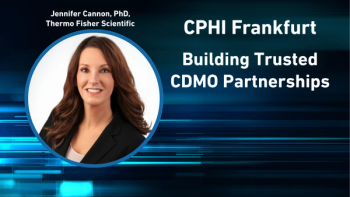
- Pharmaceutical Technology-08-01-2014
- Volume 2014 Supplement
- Issue 2
Weighing Clinical Trial Outsourcing Options
Evolving clinical trial research services give biopharmaceutical companies options for full and functional services.
Biopharmaceutical companies are facing increased research costs, along with the ongoing complexity of global regulations and market conditions. All of these variables create a diverse set of needs for biopharmaceutical research portfolios, which, in turn, create a wide range of needs in the outsourcing market. Adding to the complexity is the fact that biopharma companies have a multitude of choices in outsourcing partners and nearly as many options for contracting methods; there is truly no one-size-fits-all scenario for meeting their needs.
In some cases, the sponsor requires full-service outsourcing, in which the partner company takes full ownership of the trial deliverables. In other cases, sponsors are seeking enterprise scale on a functional level, while some simply need specific staffing solutions to meet global capacity requirements. The answer is an integrated outsourcing solution that encompasses the necessary legal, contracting, and execution expertise that enable biopharma companies to successfully meet business objectives. In this article, the authors discuss how the successful integration of the appropriate expertise can help drug sponsors maximize the value of their research investments.
The Tufts Center for the Study of Drug Development reported in 2010 that spending on new drug development was growing at a rate of 9.1% while global spending on contract clinical services was growing almost at 13.4% (1). As drug development costs have continued to increase, there has been additional pressure placed on improving R&D performance.
This improvement has been accomplished by focusing on drug development efficiency and/or by implementing new strategic partnerships and alliances (2). Both models are expected to experience continued growth (3).
As the marketplace has evolved, two primary outsourcing types have emerged (see Figure 1). The first is full-service outsourcing with an increasing trend toward alliances, in which a CRO typically is contracted to deliver all services required to execute a clinical trial and/or a portfolio of trials. The alliance model may be asset or therapeutically aligned. This method of engagement and, more importantly, contracting is focused at a trial, program, or asset level. This outsourcing method typically adheres to a unitized or milestone-based contract. However, the underlying construct is ultimately payment based upon the number of hours worked. This time-tested form of outsourcing has both advantages and disadvantages.
The second type, functional service provider (FSP)-based outsourcing, is not a new method of outsourcing, but it does not carry the same level of maturity and understanding within the broader market when compared to full service outsourcing. In many cases, FSP contracting includes large-scale contracts focused on a given functional service, such as data management, biostatistics, programming, and even monitoring. In this model, teams work across clinical trials in an effort to maintain functional consistency--both from a process and resource standpoint--to ultimately reduce the cost of delivery. Contractual structures for FSPs span from full-time equivalent (FTE) and dedicated capacity models to service-oriented, outputs-based contracting. It is here, in this evolving focus on outputs-based contracting, that will prove a significant value to the industry in driving increased innovation and aligning shared goals.
Several trends are emerging within both models:
General interest in moving away from FTE-based contracting to an FSP outputs-based model in which companies pay for a result and not a resource.
- Consistent with trends noted by Tufts CSDD, FSP and full-service outsourcing are being integrated to offer efficiencies in oversight and cost flexibility. Industry Standard Research has provided examples of the top selection drivers for these models, including the combination that provides increased resource flexibility, access to expertise, greater efficiency, reduction in development costs, lower administration burden, and improved service relationships (3).
- Although it is difficult to determine the future outlook, this article addresses a potential outsourcing model that integrates FSP and full-service outsourcing, while depending less and less on FTE models. The rationale to send trials to a full-service or functional-service provider may differ from company to company based on internal needs and core competencies. However, by leveraging both models, companies are able to maximize spend, time, and quality across a given portfolio.
Benefits and challenges in each model
Full- and functional-service models both carry unique sets of benefits and challenges that must be considered when a company pursues an FSP relationship. These benefits and challenges include the main drivers to the supply; management of resources; alignment to the core vision; accountability; and agreed standards, processes, and technology (4). These specific advantages and limitations are cornerstone to the belief that the model carrying the greatest benefit is a fully intertwined combination of the two.
As an advantage, full-service outsourcing is mature, well understood, easily deployable, and simple to contract. Most pharmaceutical companies and CROs enjoy a thorough understanding of contract terms and approach to the financials. Many, if not all, full-service models are built on an hours-/role-based assessment of what it will take to complete a trial. Another important benefit of this model is that it often allows the CRO to leverage its own systems and processes to execute the trial in an expedited fashion. The more services a CRO can execute, the more streamlined its internal operations. If the CRO is performing all services in a clinical trial, it can align its staff, processes and technologies to more efficiently execute the trial.
This full-service model offers lower risks from a contracting perspective, but it presents challenges with how bio/pharmaceutical companies perceive oversight and execution risk management. Another challenge with the full-service model is significant inefficiencies within the execution of a trial may occur due to a duplication of roles (i.e., both parties are providing oversight and direction when only one should). This lack of definition within the model often proves to be a significant challenge. Additionally, defining scope and ownership tend to be a challenge. That challenge can be due to a lack of understanding between parties or simply based on the nature of executing a complicated global trial. These scope variations ultimately may drive contract modifications and costs overruns.
A functional-service model may offer significant cost and efficiency opportunities by connecting a single functional contract to a high volume of work. Simply put, companies provide vendors an opportunity to streamline and innovate around a core set of tasks. These models also can offer contracting terms aligning delivery with the service and not to time or effort. Essentially, the company pays for the functional output and is not concerned with the hours or tasks necessary to reach that goal. Although subtle, this shift in contracting is crucial for CROs that continue to seek new and innovative ways to execute trials with increased efficiency and quality at a reduced cost to clients. One challenge in this environment is the potential for an increase in oversight requirements. Based on the structure of the contract, the added oversight sometimes can offset the potential savings. Additionally, expectations aligned with full-service oversight in an FSP environment can prove to be the limiting factor in the success of an FSP deployment. The functional model requires a full understanding of the scope and roles by both parties prior to contractual execution.
Contracting
In the two models, a key consideration is contracting and how to leverage that vehicle to improve efficiencies and drive innovation. In either case, we see the separation of hours and services delivered as a key component to driving the biopharmaceutical industry forward. In termed incentive-based contracting, the alignment of each contracting party’s goals through the contract payment vehicle is a significant move. Essentially, the industry needs to transition from focusing on hours and tasks to emphasizing the more important factors of cost and value.
For example, when using a simplistic contract unit for payment that encourages productivity and quality, both parties can build the structure of their relationship around common goals and shared incentives. When executed correctly, these units are more easily managed and operationalized, and they eliminate the need for a risk/reward component, as it is inherently built into the currency of the unit.
An example of this would be a study start-up FSP contract that establishes payments will be made to the vendor when a site is ready to receive the investigational product (IP). The currency in this case would be a site status of IP shipment eligible (IPSE), which would require all essential regulatory documents to be properly collected; ethics committee/ministry of health approvals in place; and a contract executed with the site. Productivity and quality are encouraged in this model since the CRO’s profitability hinges on its ability to perform efficiently, with no need for re-work due to quality issues. If start up is protracted, then the CRO’s profitability suffers due to extended timelines, additional efforts and over-burn. For the biopharmaceutical company, this represents a simplistic, single-payment option based on the status of when the site is ready to participate in the trial. Plus, it incentivizes process optimization and quality performance by the CRO.
What is the optimal model?
Often, in interactions with biopharmaceutical companies, there is a primary focus on one model or the other. Essentially, company X deploys a full-service outsourcing strategy and company Y capitalizes on functional services. As depicted by Figure 2, the most successful outsourcing strategies leverage both models to help manage the diverse needs of their trial portfolios.
There are several clear advantages to this combined strategy. Centralized governance saves time and oversight hours. These models also benefit from a single view across a portfolio and allow companies to adjust accordingly.
FSP can offer a cost savings when the oversight and blend of resourcing is correct, while full service can deliver critical compounds more efficiently. Combined, a company can maximize investments in both time and operations based on the needs of the portfolio. This includes strategies that take advantage of the global marketplace in order to hire and retain talented workers. The availability of global talent has improved as clinical trials have moved into new and emerging marketplaces over the past decade (5).
One size simply does not fit all. Successful companies employ a flexible strategy and engage vendors who can offer a blend of solutions.
Conclusion
So, is FSP or full service the best contracting method for a biopharma company’s needs? The answer may very well be both. Each model has its own unique advantages and challenges. When executed correctly, a combined outsourcing strategy that deploys both can yield the best of each. The most successful companies focus on internal core competencies and retain internal expertise for those competencies. From there, they identify the service(s) that would benefit most from large-scale functional outsourcing and those that would benefit from full service. The answers will vary based on the core competencies and capacity needs of each organization. Once a decision tree is built, the company can work within a network of vendors that offers the flexibility to maximize returns both financially and operationally.
References
1. Estimates for Global Demand for Clinical Services Outsourcing, Tufts Center for the Study of Drug Development, Outlook 2010. (January 2010).
2. R&D Trends, Tufts Center for the Study of Drug Development. Outlook 2014 (January 2014).
3. Clinical Development Outsourcing Dynamics. ISR Reports. Clinical Development Outsourcing Models (October 2013).
4. A. S. Townshend and P. Carberry, Contract Pharma, 15 (2) (2013).
5. KI Katin, Pharm Outsourcing 11(3) (2010).
About the Authors
Bryan Haas is vice-president and Dave Agrella is executive director, Functional Service Partnerships; and Scott Maisto is associate director, strategic finance, all at PPD, Wilmington, NC; email: ppdinfo@ppdi.com.
Articles in this issue
over 11 years ago
Contractors Invest in Capacity and Capabilitiesover 11 years ago
Quality by Design in Contract Service Relationshipsover 11 years ago
Technologies Key for Biologics to Meet Expectationsover 11 years ago
Analytical Labs Strive to Deliver More Information, Fasterover 11 years ago
Positive Outlook for Outsourcingover 11 years ago
CMOs Target Parenteral Drug Development Needs Both Large and Smallover 11 years ago
Solid-Dosage Forms Demand Traditional and Emerging Technologiesover 11 years ago
Shifting Gears in Drug Development Outsourcing Responsibilitiesover 11 years ago
A Silver Milestone for Drug DevelopmentNewsletter
Get the essential updates shaping the future of pharma manufacturing and compliance—subscribe today to Pharmaceutical Technology and never miss a breakthrough.




